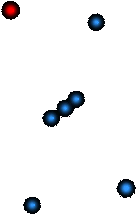Winter nights are glorious!
There is something special about the winter stars that makes the bitter
cold tolerable. They seem to have an extra sparkle. There is some truth
to this because the cold night air is dry, which makes the sky crystal
clear and clean. Not to mention that of the 25 brightest stars, 12
twinkle in the winter skies. Six of these stars form the "Winter
Hexagon", which dominates the winter sky.
Our tour of the Winter Hexagon begins with the brilliant blue-white
star Rigel, which forms the left leg of Orion "the Hunter". In late
December Orion can be found in the southeast at 8:00 p.m. Orion is one
of the most recognizable star patterns, second only to the Big Dipper.
To remember the hunter's form, simply memorize this "nursery" rhyme:
Three
stars in a row,
Two above and two
below!
|
 |
The two stars above form Orion's shoulders; the two below form his
legs. The three stars in a row form Orion's belt, hanging from the belt
is a sword. Take a good look at the sword, one of the stars appears
"fuzzy". A closer look with a pair of binoculars or a small telescope
reveals one of nature's true wonders. That fuzzy patch is the Great
Nebula in Orion, a star-forming region 1500 light-years away!
![[Capella]](images/stargazing/capella.jpg)
At the
top of the hexagon is Capella, shining with a hint of golden yellow in
the house-shaped constellation Auriga "the Charioteer". Capella is
actually a binary star, two stars that orbit a common center of
gravity. Both stars are giant versions of our Sun.
Following Orion's belt up and to the right leads us to the next star of
the Winter Hexagon. The red-orange star is Aldebaran, located in Taurus
"the Bull".
Moving straight down and to the left of Capella are two stars of nearly
equal brightness. These two stars form the heads of the Gemini twins,
Castor and Pollux. Pollux is the brighter of the two, but Castor is a
wonderful triple star system visible through a modest size telescope.
Low in the east is Procyon forming one end of the two star
constellation, Canis Minor. The sixth corner of the Hexagon is the
brightest star in the night sky, Sirius. This giant white star in Canis
Major, the Greater Dog, is only 8.8 light-years away. This loyal dog
follows his master Orion across the sky through the course of a cold
winter night.
![[Rhapsody of a Winter Night]](images/stargazing/winter.jpg)
![[Rhapsody of a Winter Night]](images/stargazing/winter.jpg)